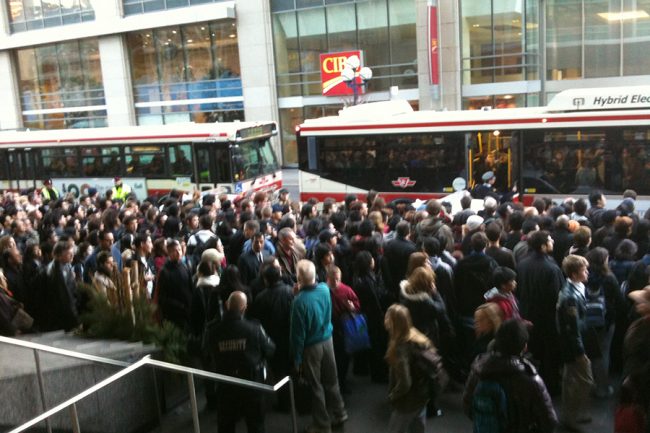
It’s a phrase transit riders hear all too often: “Shuttle buses are on the way.”
Service disruptions are a fact of life for transit systems around the world. The most common remedy is “bus bridging,” in which buses are pulled from regular routes and dispatched to serve as shuttles along the disrupted rail segment.
But the transition rarely goes smoothly. If the buses are not dispatched in time, or if there are not enough of them along a given route, the result is overcrowding, delays and less efficient operation. In New York City alone, major subway disruptions have been estimated to cost $389 million per year in lost wages and productivity.
Professor Amer Shalaby (CivMin) and his team are working on solutions. Over the past few years, they have conducted a number of studies to pinpoint the key factors that determine successful bus bridging deployment, and developed tools that transit agencies can use to make better decisions.
“Bus bridging has gained growing attention in recent years due to the dire need for more efficient strategies to counter the effects of unplanned disruptions of rail service, which are happening more frequently,” says Shalaby. “Our approach is unique in terms of the balance it achieves between a theoretically robust procedure and practical application.”
Much of the team’s work has been conducted by analyzing incident reports provided by transit agencies such as the Toronto Transit Commission (TTC). Using tools from machine learning and queuing analysis, the team was able to recognize factors that have a big impact on the outcome, but which are not always taken into account
“A current strategy might focus the number of buses needed based on the length of the disruption, say 10 buses every 10 minutes,” says Alaa Itani, a PhD candidate in Shalaby’s Transit Analytics Lab. “But it is equally important to consider other factors, such as which routes to pull the buses from, and where to start their initial service.”
Itani gives the example of a real disruption in Toronto in 2015 that affected eight stations and lasted for 60 mins. Her analysis suggested that the buses used in this case were too few and too far away to effectively deal with the disruption. Using more buses from routes closer to the incident could have cut passenger delays and the longest queue at the disrupted stations by 50%.
Even in cases where the number of buses is held constant, being more strategic about which buses were used and where can make a difference. In the above case, Itani’s models suggest that this approach could have reduced total user delays by about 23%.
“There is always a compromise between how far the dispatched buses are and how many riders they would otherwise serve,” says Itani. “If we pay more attention to maintaining that balance, we can get better outcomes.”
Still, Itani says that there are some situations where shuttle buses simply cannot get to the scene fast enough.
“Our analysis showed that while bus bridging can be effective in less congested subway segments, there are places in the downtown core where bus bridging is constrained by the road or curb capacity at the affected subway stations and thus it is not enough,” says Itani.
“In these cases, agencies are recommended to follow supplementary mitigation plans like directing passengers to parallel routes or encouraging passengers to continue their trips using active modes.”
The team has developed two decision support tools to help transit agencies deploy bus bridging more effectively. The first, called DASh-Bus Planner, is designed to help transit agencies assess different shuttle bus deployments and scenarios. The second, called DASh-Bus Optimizer, provides transit operators with a near optimal bus bridging plan in the event of an unplanned rail disruption.
Itani says that not only could these tools help agencies better manage disruptions, but they could also provide strategies to reduce crowding due to ordinary surges in ridership.
“Transit agencies are usually risk averse, so we understand that it may be challenging for them to make the kinds of changes recommended by our tools,” says Itani. “However, the recent pandemic has forced the issue. The disruptions they are currently dealing with could provide an opening for them to re-think their traditional approaches.”
By Tyler Irving
This article originally published by U of T Engineering